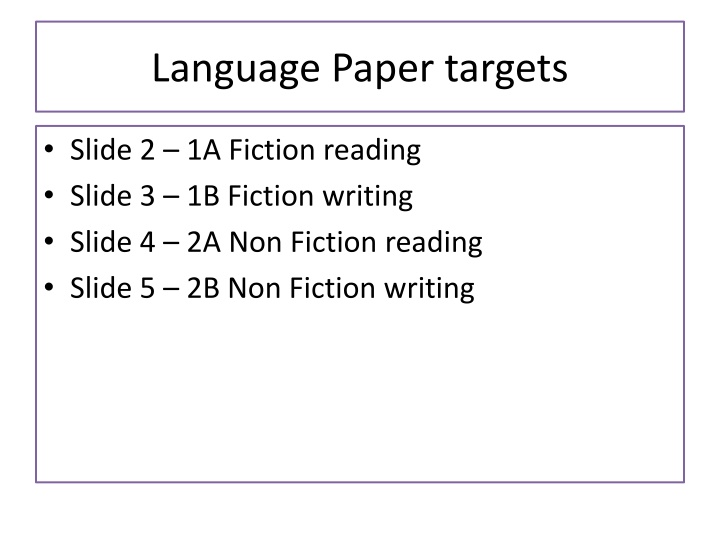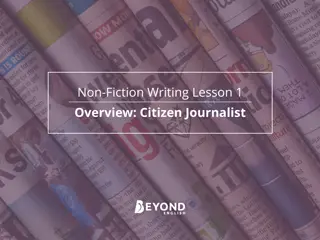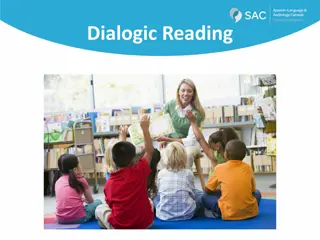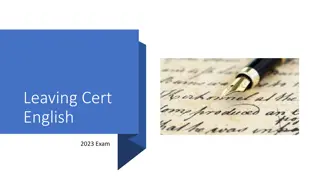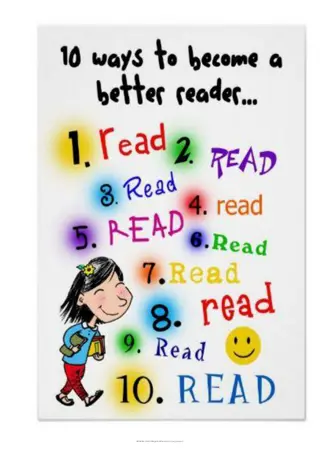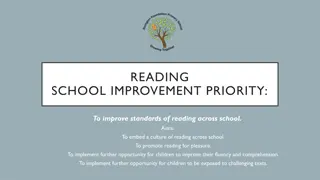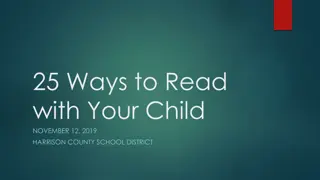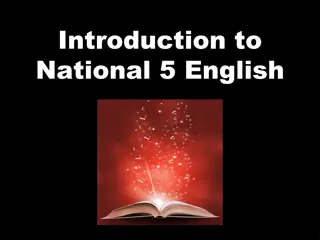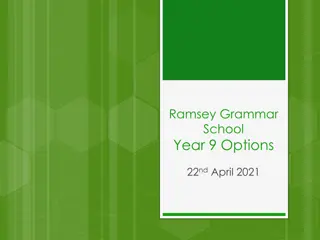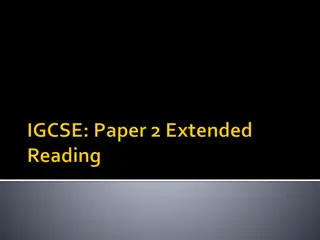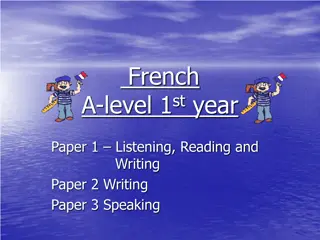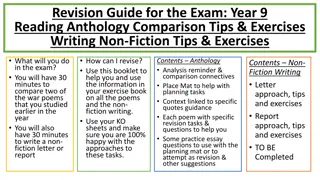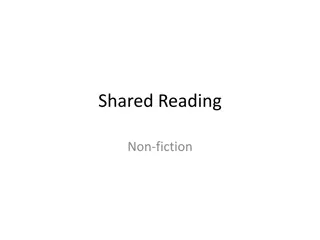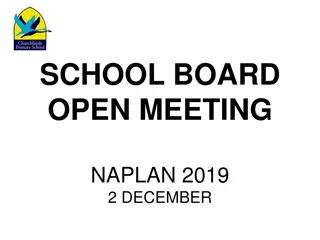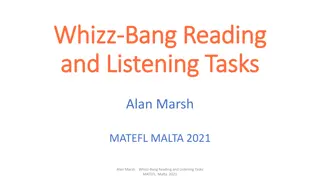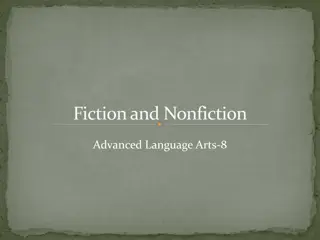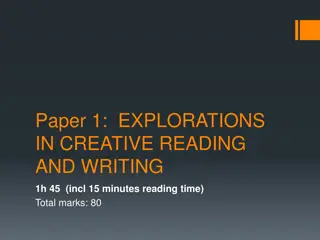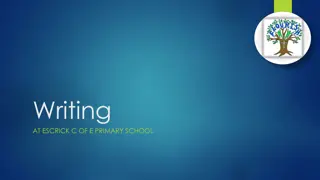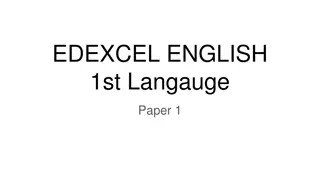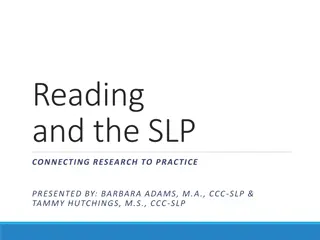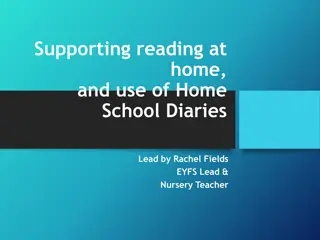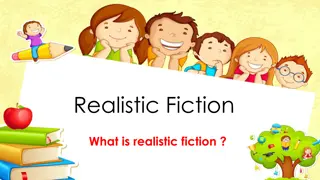Language Paper Targets for Fiction and Non-Fiction Reading and Writing
This content provides detailed targets for Language Papers, focusing on Fiction and Non-Fiction reading and writing skills. It covers strategies such as being specific in analysis, using evidence from texts, improving sentence structures, enhancing vocabulary usage, and applying language techniques effectively. The targets are aimed at developing students' abilities in interpreting and creating literary works.
Download Presentation

Please find below an Image/Link to download the presentation.
The content on the website is provided AS IS for your information and personal use only. It may not be sold, licensed, or shared on other websites without obtaining consent from the author.If you encounter any issues during the download, it is possible that the publisher has removed the file from their server.
You are allowed to download the files provided on this website for personal or commercial use, subject to the condition that they are used lawfully. All files are the property of their respective owners.
The content on the website is provided AS IS for your information and personal use only. It may not be sold, licensed, or shared on other websites without obtaining consent from the author.
E N D
Presentation Transcript
Language Paper targets Slide 2 1A Fiction reading Slide 3 1B Fiction writing Slide 4 2A Non Fiction reading Slide 5 2B Non Fiction writing
Targets for Language Paper 1A (A1-A5): Fiction Reading 1. 2. 3. 4. 5. 6. 7. 8. 9. 10. 11. 12. 13. 14. 15. 16. 17. Be more specific (don t waffle) Select information from the relevant section of the text Read the question more carefully Use evidence (quotes) from the text Comment on the text Explain my views in more detail Analyse why I think this about the text Compare the two texts Use the terminology: e.g. metaphor, rule of three, imagery etc. Explore why the writer has used particular terminology Select information from both texts Ensure information is relevant to the question Think about how tension and drama is created Be concise in the way I write Work on timing to cover all questions Use more quotes Be specific about the quotes I select short quotes that have a meaning
Targets for Language Paper 1B: Fiction Writing - Creative writing targets 1. 2. Learn techniques to remember tricky spellings Revise simple, compound and complex sentences, focus on using all three types in your writing and that you use these for effect Read work out loud to check it makes sense and is well-expressed Try using very short sentences occasionally for dramatic effect Start your sentences in a variety of ways to show sophistication in your sentence structures: adverbs, connectives Use vocabulary that is appropriate for your audience Use more imaginative, interesting and precise vocabulary and avoid repeating the same vocabulary Vary the use of connectives to add interest to your writing Ensure ideas are fully developed within paragraphs Vary the length and style of your paragraphs if appropriate for effect Check and correct basic sentence punctuation Practise use of commas Check and correct advanced punctuation for effect: use a wide range of punctuation. 3. 4. 5. 6. 7. 8. 9. 10. 11. 12. 13.
Targets for Language Paper 2A (A1-A6): Non-Fiction Reading 1. 2. 3. 4. 5. 6. 7. 8. 9. 10. Adapt your vocabulary more to show understanding 11. Compare more 12. Explore the effect of language 13. Explain how the writer creates effect Use the PEA structure more effectively Offer opinions in more detail Refer specifically to evidence from the text Refer to language techniques Explore the techniques in more detail Focus on structure as well as language Be more persuasive in your A4 answer Develop more reference to a range of examples Use good subject terminology
Generic targets for Language Paper 2B: Non- Fiction Writing Transactional writing targets 1. 2. 3. 4. 5. Check the Purpose, Audience and Format of the task carefully Be aware of the formality of your writing Support your opinions with developed ideas and opinions Learn techniques to remember tricky spellings Revise simple, compound and complex sentences, focus on using all three types in your writing and that you use these for effect Read work out loud to check it makes sense and is well-expressed Start your sentences in a variety of ways to show sophistication in your sentence structures: adverbs, connectives Use vocabulary that is appropriate for your audience Use more imaginative, interesting and precise vocabulary and avoid repeating the same vocabulary Vary the use of connectives to add interest to your writing Ensure ideas are fully developed within paragraphs Vary the length and style of your paragraphs if appropriate for effect Check and correct basic sentence punctuation Practise use of commas Check and correct advanced punctuation for effect: use a wide range of punctuation 6. 7. 8. 9. 10. 11. 12. 13. 14. 15.
Literature targets Slide 7: 1A (a) Shakespeare extract Slide 8: 1A (b) Shakespeare essay Slide 9: 1B (a) Poetry Anthology single poem Slide 10: 1B (b) Poetry Anthology comparison Slide 11: 2A LOTF/BB/AIC extract with whole play Slide 12: 2B A Christmas Carol extract with whole play Slide 13: 2C (a) Unseen Poetry single essay Slide 14: 2C (b) Unseen Poetry comparison essay
Targets for 1A: (a) extract Lit Shakespeare 1. 2. 3. 4. 5. Refer to the way language/structure is used more Link to the question regularly Be precise in my answer don t waffle Analyse By asking myself these questions Why do I think that? What else could it suggest? What other interpretations could I come up with? Is it relevant and does it add to my answer? Develop my response in detail Ensure I link to the extract Use enough quotes from the extract 10. Ensure I think about the themes 11. Ensure I think about how different audiences would have appreciated the text 12. Ensure I have used appropriate subject terminology 6. 7. 8. 9.
Targets for 1A: (b) Whole text essay Shakespeare 1. 2. 3. 4. 5. 6. 7. 8. Check my punctuation Check my spelling Check my sentences make sense Refer to the way language/structure is used more Link to the question regularly Be precise in my answer don t waffle Analyse By asking myself these questions Why do I think that? What else could it suggest? What other interpretations could I come up with? Is it relevant and does it add to my answer? Develop my response in detail Ensure I link to the extract Use enough quotes from the extract Ensure I think about the themes Ensure I think about how different audiences would have appreciated the text Ensure I have used appropriate subject terminology 9. 10. 11. 12. 13. 14. 15.
Targets for 1B (a) Poetry single essay 1. 2. 3. 4. 5. Refer to the way language/structure is used more Link to the question regularly Be precise in my answer don t waffle Analyse By asking myself these questions Why do I think that? What else could it suggest? What other interpretations could I come up with? Is it relevant and does it add to my answer? Develop my response in detail Ensure I link to the context at the time Ensure I think about how different audiences would have appreciated the text 10. Ensure I have used appropriate subject terminology 11. Add more development of context 6. 7. 8. 9.
Targets for 1B (b) Comparison essay 1. 2. 3. 4. 5. Refer to the way language/structure is used more Link to the question regularly Be precise in my answer don t waffle Analyse By asking myself these questions Why do I think that? What else could it suggest? What other interpretations could I come up with? Is it relevant and does it add to my answer? Develop my response in detail Compare the meaning effectively Use the language of comparisons connectives to compare 10. Ensure I link to the context at the time 11. Ensure I think about how different audiences would have appreciated the text 12. Ensure I have used appropriate subject terminology 6. 7. 8. 9.
Targets for 2A: LOTF/BB/AIC extract bringing in whole text 1. 2. 3. 4. 5. 6. 7. 8. Check my punctuation Check my spelling Check my sentences make sense Refer to the way language/structure is used more Link to the question regularly Be precise in my answer don t waffle Analyse By asking myself these questions Why do I think that? What else could it suggest? What other interpretations could I come up with? Is it relevant and does it add to my answer? Develop my response in detail Ensure I link to the extract and then bring in the whole text Use enough quotes from the extract Learn more quotes from the rest of the text Ensure I think about the themes Ensure I think about how different audiences would have appreciated the text Ensure I have used appropriate subject terminology 9. 10. 11. 12. 13. 14. 15. 16.
Targets for 2B: A Christmas Carol 1. 2. 3. 4. 5. Refer to the way language/structure is used more Link to the question regularly Be precise in my answer don t waffle Analyse By asking myself these questions Why do I think that? What else could it suggest? What other interpretations could I come up with? Is it relevant and does it add to my answer? Develop my response in detail Ensure I link to the extract and then bring in the whole text Use enough quotes from the extract 10. Learn more quotes from the rest of the text 11. Ensure I think about the themes 12. Ensure I think about how different audiences would have appreciated the text 13. Ensure I have used appropriate subject terminology 6. 7. 8. 9.
Targets for 2c: (b) Lit Unseen comparison essay 1. 2. 3. 4. 5. Refer to the way language/structure is used more Link to the question regularly Be precise in my answer don t waffle Analyse By asking myself these questions Why do I think that? What else could it suggest? What other interpretations could I come up with? Is it relevant and does it add to my answer? Develop my response in detail Compare the meaning effectively Ensure I link to the context at the time Ensure I think about how different audiences would have appreciated the text Ensure I have used appropriate subject terminology Compared specific ideas/themes/quotes from the poems Compared the language and structure Explored context more specifically 6. 7. 8. 9. 10. 11. 12. 13. 14.
Targets for 2C: Lit Unseen single essay poem 1. 2. 3. 4. 5. Refer to the way language/structure is used more Link to the question regularly Be precise in my answer don t waffle Analyse By asking myself these questions Why do I think that? What else could it suggest? What other interpretations could I come up with? Is it relevant and does it add to my answer? Develop my response in detail Ensure I link to the context at the time Ensure I think about how different audiences would have appreciated the text 10. Ensure I have used appropriate subject terminology 6. 7. 8. 9.
